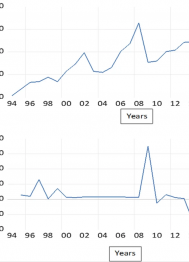
Assessment of port efficiency within Latin America
The Panama Canal expansion has influenced the development of ports within the Latin America and the Caribbean (LAC) region, intending to capitalise on economic opportunities through seaborne trade. Examining port performance is essential to ascertain the PCE impact on port efficiency within the LAC region. Stochastic frontier analysis (SFA) was used to determine the technical efficiency of the 19 major ports within the LAC from 2010 to 2018. The result indicates that, among the four (4) port performance indicators (berth length, port area, the number of cranes (STS gantry and mobile), and the number of berths), the number of STS gantry cranes and berth length had the largest and most significant impact. Some ports with high technical efficiency experienced TEU losses despite port infrastructural development and privatization. The findings also revealed that the increased competition among regional and US East and Gulf Coast ports has negatively impacted some LAC ports’ TEU volumes due to port proximity. The dynamism of the maritime sector, especially containerization, requires ports to implement value-added services and logistics centers in tandem with port performance indicators to remain sustainable and competitive in the maritime industry.
The evolution in supply chain and logistics models has caused container terminals to rethink their logistics processes. The concept of ports and their functions has evolved throughout the decades. In the nineteenth and twentieth centuries, the port sector tended to be instruments of the state, and port access was deemed to control markets. As a result, there was a minimum competition between ports, and ports related costs were insignificant compared to ocean and inland transport costs, resulting in a lack of initiative to improve port efficiency (PE). Currently, ports are competing globally and reaping tremendous gains from ocean transportation and improvement in logistics. This drive has made the port sectors focus on improving PE, lower cargo throughput handling costs, and providing added value service to catering to other components of the global distribution network (Talley 2017; Notteboom et al. 2021). Port activity and seaborne trade are often associated with positive socio-economic effects, such as GDP and employment growth (Nogué-Algueró 2019; Notteboom et al. 2021; Munim and Schramm 2018; Rodrigue 2020; Talley 2006, 2017). In addition, ports are the drivers of urban and regional economic growth, which is a function of port productivity (Lonza and Marolda 2016; Munim and Schramm 2018; Talley 2017; Shetty and Dwarakish 2018).


